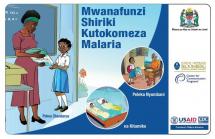School Net Program – Cue cards
The Tanzania School Net Program involved distribution of treated nets to both children ages 6-14 years and heads of household as primary audiences, empowering these audiences to take action while clearly conveying the benefits of getting everyone covered – including neighbors – by drawing on popular “sharing” beliefs that exist in Tanzania. The school net program (SNP) also targeted primary school teachers, TCCP Community Change Agents, Ward Educational Coordinators, and other stakeholders, including local government authority (LGA) officials, heads of schools, ward and village officials.
The effort included community outreach, radio spots, district-wide events, and school activities.
Through the Patapata radio program, children were inspired to talk to their parents, friends, and communities about malaria prevention behaviors such as sleeping under a net every night, proper net use, net care and repair, and net sharing. Anecdotal feedback from Community Change Agents indicated that children enjoyed the program, and that parents reported increased interpersonal communication with their children about the importance of sleeping under the nets they were given at school.
The attached file includes a mathematics table backed by a card reminding the student about the nets, as well as a cue card informing the family about the use of bednets.
Source: Johns Hopkins University Center for Communication Programs
Date of Publication: March 25, 2019
SIMILIAR RESOURCES
Tools
Examples
- SBCC for Malaria in Pregnancy: Strategy Development Guidance
- The P Process
- Care of Mosquito Nets Toolkit
- ITN Access and Use Report 2018
- ITN Access and Use - Mapping Net Culture in Sub-Saharan Africa
- Key considerations: Quarantine in the Context of COVID-19
- Social and Behavior Change for Insecticide-Treated Nets (ITN)
- Understanding ITN Use: What do your Numbers Really Mean? - Webinar and Presentation
- Incorporating Net Care into Malaria Social and Behavior Change Communication Strategies: A Step-by-Step Guide
- ITN Access and Use Report

